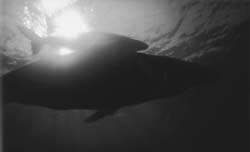
![]()
Volume 6, No. 2
Promoting Cooperation to Maintain and Enhance
Environmental Quality in the Gulf of Maine
|
||||||||||
|
Regular columns |
|
Archives |
|
About |
By Maureen Kelly
The experimental sonar, currently on one ship, the R/V Cory Chouest, cost $350 million to develop and is designed to detect the newest generation of quiet submarines. The SURTASS LFA has an active component that emits a sound pulse that echoes off objects in the water. Its low-frequency pings travel greater distances through water than higher frequencies, so the SURTASS LFA has a greater range than other sonars.
The sonar operates at a frequency of between 100 to 500 hertz, within the hearing range of many marine mammals and fish. While better able to detect distant submarines, some environmentalists fear that the sonar will also have a farther reach in terms of impacting sea life and that sounds broadcasting from a ship's hydrophones will prove detrimental to wildlife.
Other nations have developed low frequency sonars as well and, like the United States, are in the testing phases. However, Navy spokesman Lt. Patrick McNally said, "The U.S. is the only one going this low - down to 500 hertz."
Evidence has shown that certain sonars can be harmful to mammals. The military took responsibility for the stranding of 16 whales in the Bahamas in March 2000 that resulted from the Navy's testing of mid-frequency sonar. The carcasses of the whales that died showed signs of auditory trauma.
"Scientific evidence is compelling that mid-range tactical sonar used by U.S. warships can seriously affect certain marine mammals under certain circumstances," said Roger Gentry of NMFS's Acoustic Research team in a written statement. But, he added, "Many kinds of sonars exist, all with different operating characteristics...Because of these differences science does not support the conclusion that these same effects will be caused by sonars other than mid-range tactical sonar. This is a highly technical field that offers few simple, straightforward answers."
In October 2001, Hawaii's Congresswoman Patsy T. Mink testified before the House Subcommittee on Fisheries Conservation, Wildlife and Oceans expressing concern that the SURTASS LFA could harm marine mammals, with low frequency broadcasts having the potential to change behaviors and affect breeding and rearing of young. Furthermore, she said the Navy would be in violation of the Marine Mammal Protection Act (MMPA) if the sonar were deployed. The Navy has requested a "small take" exemption under the MMPA from the NMFS, which would allow incidental disturbances to a small number of mammals from the operation of the sonar.
The Natural Resources Defense Council (NRDC) also expressed concerns to NMFS about the sonar's potential harmful effect on marine mammals including the east coast's endangered Northern right whales. The Navy reported that it does not intend to deploy the sonar in the Gulf of Maine ¾unless the United States is under threat conditions¾because it is an important habitat area, but the NRDC was unappeased.
Northern right whales migrate "well offshore of the continental United States and Canada and well outside the Navy's Offshore Biological Exclusion Area, where presumably the risk of impact would increase," the group stated in a letter urging NMFS to deny the Navy's application for a take exemption.
While there is disagreement about the impacts that low-frequency sonars will have on animals, uncertainty also remains over the long-term effects that other man-made sounds are having on the ecosystem.
Gentry stated, "There is no scientific evidence that shipping, construction or oil and gas development are having severe, lasting effects on marine mammals." But, he added, "This does not mean that these sound sources are having no effect, only that the effects, if any, are not being detected."
Researchers trying to determine how noise interferes with behaviors among mammals, fish and ocean-going reptiles recognize that the hearing ranges of species differs and noise in the environment does not affect all creatures in the same way.
Mammal acoustics are completely different from fish acoustics, said Phillip Lobel, an ichthyologist and associate professor of biology at the Boston University Marine Program. Among fish, hearing can range from 50 to 800 hertz depending on the species, he said.
Other factors that contribute to noise impact on wildlife include the intensity of the sound, duration, frequency, pressure and distance the animal is from the sound source and whether the sound is traveling through deep or shallow water.
In his studies Lobel found that if a noise is "loud enough and persistent enough" it will disturb fish. But, he added, "Just because a disturbance is occurring doesn't mean it's having an adverse impact."
There can be "disturbance because of novelty," he said, though some fish adjust to the racket. In one study, he discovered that fish became acclimated to noise from heavy boat traffic and were able to spawn normally.
Scientists have more to learn about whether noise pollution is disrupting normal biological activities. In February, the Navy announced its decision to fund the North Pacific Acoustic Laboratory project, which will study long distance sound transmissions in the ocean and their long-term effects on sea life.
Man-made sound in the oceans is gaining more recognition as a potential threat to sea life. Commercial shipping, seismic surveys, activities associated with oil and gas exploration and sonar all contribute to noise pollution in the sea. Some believe that the din from machinery could disrupt biologically important behaviors like communication, mating, migrating, feeding and rearing of young.
A new noisemaking technology may get approval to operate in the seas in the next few weeks when the National Marine Fisheries Service (NMFS) makes a final decision on whether the U.S. Navy can proceed with the deployment of its new Surveillance Towed Array Sensor System Low Frequency Active sonar (SURTASS LFA).

Humpback whale and calf
A fish's sensitivity to sound depends on various physical factors, such as whether or not it has a swimbladder-an organ involved in buoyancy and sound production-and whether it is a salt-water or fresh-water species. Lobel believes that fresh-water fish may have more acute hearing that allows them to detect predators in murky waters.

Cunner fish
Source: NOAA photo library